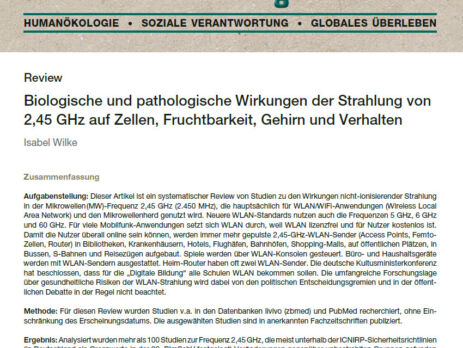Is wifi harmful to health?
Biological and Pathological Effects of 2.4 GHz WiFi Radiation on Cells, Fertility, Brain, and Behavior. By Isabel Wilke. Source: Environment • Medicine • Society. Special Edition in issue 1-2018. Translated from German by JRS.
A very robust review article with thematically sorted discussion of scientific studies in detail – JRS.
What effects do studies on WiFi show?
Studies show that WiFi radiation causes oxidative stress, DNA damage, sperm damage, EEG changes, and other effects.
This article is a systematic review of studies on the effects of non-ionizing radiation in the microwave (MW) frequency 2.45 GHz (2,450 MHz), which is mainly used for WLAN/WiFi (Wireless Local Area Network) applications and the microwave oven. Newer WiFi standards also use the 5 GHz, 6 GHz and 60 GHz frequencies.
WiFi is gaining acceptance for more and more applications because it is license-free and free of charge for users. To enable users to be online everywhere, more and more pulsed 2.45 GHz WiFi transmitters (access points, femto cells, routers) are being set up. The extensive research on health risks of WiFi radiation is generally ignored by the decision-making bodies, in politics and in the public debate.
Method
For this review, studies were primarily searched in the databases livivo (zbmed) and PubMed, without restriction of the date of publication. The selected studies were published in peer-reviewed journals.
Results
More than 100 studies on the frequency 2.45 GHz were analyzed, most of which found effects at levels below the ICNIRP safety guidelines (in Germany established as limits in the 26th BImSchV) compared to non-irradiated groups. Documented are studies on damage to fertility, on effects on EEG and brain functions, on DNA and cancer development, on effects on heart, liver, thyroid, gene expression, cell cycle, cell membrane, bacteria and plants. Many studies identify oxidative cell stress as the mechanism of action. Negative effects on learning, memory, attention, and behavior are the result of cell toxic effects.
Recommendiations: limit the use of WiFi
Based on the extensive body of research and the adverse health effects found in the vast majority of studies, it is recommended that measures be taken to reduce exposure to radiation. Wired solutions should be preferred. Current limits and SAR values do not protect against the health risks of WiFi radiation. The negative effects on learning, attention, and behavior justify the avoidance of WiFi applications for educational institutions of all ages.
Because of the cell-toxic effects, WiFi is not suitable as a technology in hospitals and for telemedicine. WiFi should not be used in bedrooms, workplaces, recreation rooms, hospital rooms, lecture halls, classrooms, and public transportation. The potential hazards of WiFi radiation could be circumvented with the testing of alternative transmission techniques using other frequency bands, such as optical VLC/LiFi (Visible Light Communication) technology. If WiFi cannot be avoided as a temporary solution, the ALARA principle must be followed: no permanent radiation, but a WiFi that can be switched off and power-controlled.
Contents of the review of studies of WiFi and health
Introduction
1. reproduction and fertility
1.1 Effects on testes and sperms
1.2 Female reproduction – studies on pre- and postnatal effects
2 EEG, brain and brain development
2.1 The importance of the 10 Hz pulse
3. effects on behavior
4. influences on DNA – tumor initiating and tumor promoting damage potentials
4.1 Influences on DNA
4.2. influences on cancer (cells)
5. effects on cardiac activity
6. mechanism of action of oxidative cell stress
6.1 wifi leads to oxidative cell damage
6.2. substances to protect the cells
7. effects on the cell cycle
8. effects on the liver
9. effects on the thyroid gland
10. effects on gene expression
11. effects on the cell membrane
12. effects on bacteria
13. effects on plants
14. studies that found no effects
15. discussion and conclusions
Appendix: Table, Literature, Register
To full pdf article (in German).



